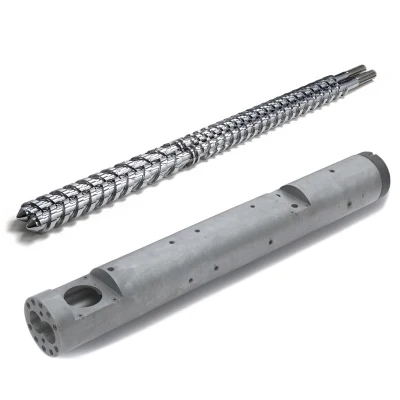We provide custom solutions to all our customers and offer complete technical advices that your company can take advantage of.
In the world of plastic manufacturing, pelletizing plays a crucial role in transforming raw materials into high-quality plastic pellets. To achieve optimal pelletizing performance, it is essential to choose the right screw and barrel combination. Screw and barrel products, service and solution direct from manufacturer.
Understanding Pelletizing Requirements:
Different materials have varying pelletizing requirements. Consider the material characteristics, such as viscosity, melt temperature, and shear sensitivity, to determine the appropriate screw and barrel combination.
Analyze the desired pellet size, shape, and quality specifications to identify the necessary screw and barrel configuration.
Screw Design Considerations:
The screw design should be tailored to the material being pelletized. Factors like the compression ratio, flight depth, and pitch play a significant role in achieving efficient melting, mixing, and conveying of the material.
Choose between single-flight and multi-flight screws based on the material's characteristics and the desired level of mixing and shearing.
Barrel Configuration:
The barrel should be selected based on the material's heat sensitivity and the required level of temperature control. Consider options like electric heating, cooling jackets, or circulating oil systems for precise temperature management.
Optimize the barrel length to ensure sufficient residence time for melting, mixing, and venting of the material. Shorter barrels promote faster processing, while longer barrels enhance material homogeneity.
Material-Specific Considerations:
For materials prone to degradation or thermal instability, choose a screw and barrel combination with efficient cooling capabilities to prevent overheating during the pelletizing process.
Materials with high filler content or additives may require specialized screw designs, such as barrier screws, to ensure uniform dispersion and prevent agglomeration.
Benefits of Choosing the Right Combination:
Improved pellet quality and consistency, leading to enhanced product performance and reduced waste.
Increased productivity and efficiency through optimized melting, mixing, and conveying of the material.
Reduced energy consumption and lower production costs by using an appropriate screw and barrel combination tailored to the material's specific requirements.
Venting and Degassing:
Materials that release gases or have volatile components during the pelletizing process require efficient venting systems. Choose a screw and barrel combination with proper vent design to remove entrapped air and gases effectively, ensuring high-quality pellets.
Screw and Barrel Wear Resistance:
Consider the wear resistance properties of the screw and barrel materials, especially when processing abrasive materials or high-fillers. Opt for hardened steel or nitride-treated components to extend the lifespan of the equipment and minimize downtime.
Barrel Heating Zones:
Some materials benefit from multiple heating zones in the barrel to precisely control the temperature profile. Different temperature settings along the barrel length can optimize melting, mixing, and homogenization, resulting in improved pellet quality.
Screw Speed and Torque:
Adjusting the screw speed and torque can significantly impact the pelletizing process. Higher screw speeds promote faster throughput, while lower speeds allow for better melting and mixing. Consider the material's characteristics and desired pellet properties when setting the screw speed and torque.
Screw and Barrel Maintenance:
Regular maintenance and cleaning of the screw and barrel are crucial for consistent pelletizing performance. Follow manufacturer guidelines for cleaning procedures, inspect for wear and damage, and schedule routine maintenance to ensure optimal operation.
Customization Options:
Manufacturers often offer customized screw and barrel combinations to meet specific process requirements. Discuss your unique needs with suppliers to explore options such as specialized screw designs, coatings, or material selections for enhanced pelletizing performance.

